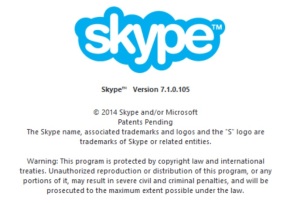The purpose of this article to explore the integration between Lync and Skype. This was enabled ages ago for Voice. And recently in November, Microsoft has announced the availability of Video between Lync and Skype. This was a feature that everyone’s waiting for. There were rumors that Microsoft will enable this feature on the upcoming Skype for Business server but luckily, it jumped the gun before that.
The functionality was enabled couple of months ago in mid November and it worked for a while. And it got disabled due to some reason (could be bugs) till further notice. Now, it’s back once again. The integration only works with the Skype client version 7.1.0.105 which can be downloaded from Skype web site
Since the acquisition of Skype, Microsoft mentioned the the voice coded that’s been used in Skype, is the most optimised voice codec to send voice over wide area network. The codec is called “Silk“. This codec was embedded to Lync’s SDP list by a Cumulative Update but, it’s not getting used so far. Below is a SDP list of an INVITE from Lync 2013 client to another Lync 2013 client. 
Even though it’s offering Silk, the client settle with the MSRTA codec which is the heights on priority. The Silk codec is lost between the negotiation process.
So getting back to the topic in hand and looking at a call between Skype and Lync, If the call originated with Skype, Skype surprisingly wants the call to be established over G722 as a priority even though Microsoft stated that it will be using Silk as a priority form going forward;
“This includes built-in security, with enterprise class encryption of both media and signaling using TLS and SRTP, enabled by default. It includes connectivity, with standards-based traversal of personal and corporate firewalls using STUN, TURN and ICE. It includes high quality, scalable video using the industry standard H.264 SVC codec. Finally, it includes the SILK audio codec as the default choice for Lync to Skype calls. SILK is used for billions of minutes of audio calls every day, and provides a phenomenal balance between audio quality, bandwidth utilization and power consumption”
Below is the snapshot of the SDP list that getting offered within the invite it self from from Skype to Lync;
But, Lync client always uses MSrta codec. So the call between Lync and Skype will settle for MSrta that is the 3rd in priority even though Lync is capable of working with G722 which is the highest priority next to Silk.
In the other hand, calling from Lync to Skype, Lync offers MSrta as a priority and Skype settle down with MSrta without any drama. Again, no Silk in the picture.
As for the Video, Microsoft has introduced H.264 SVC to support natively with Lync 2013 which allows the client to VC end points such as Polycom without having to use MSrtv as the video codec. For video integration between Lync and Skype, Microsoft have used H.264 SVC instead of the MSrtv. The SDP list that offered from Lync has the H.264UC as the priority and the call get established over H.264 SVC. 
I was under the impression that Lync will use Silk when it’s communicating with Skype and it was confirmed by Microsoft that it will be the case. Unfortunately, it’s not. As clearly shown above, it use MSrta as audio and as promised, it use H.264 SVC as video.
So hopefully when Skype for Business comes out, it will use the full strength of Silk codec for audio and we could hope for a better voice quality than what we are getting now in the future.
